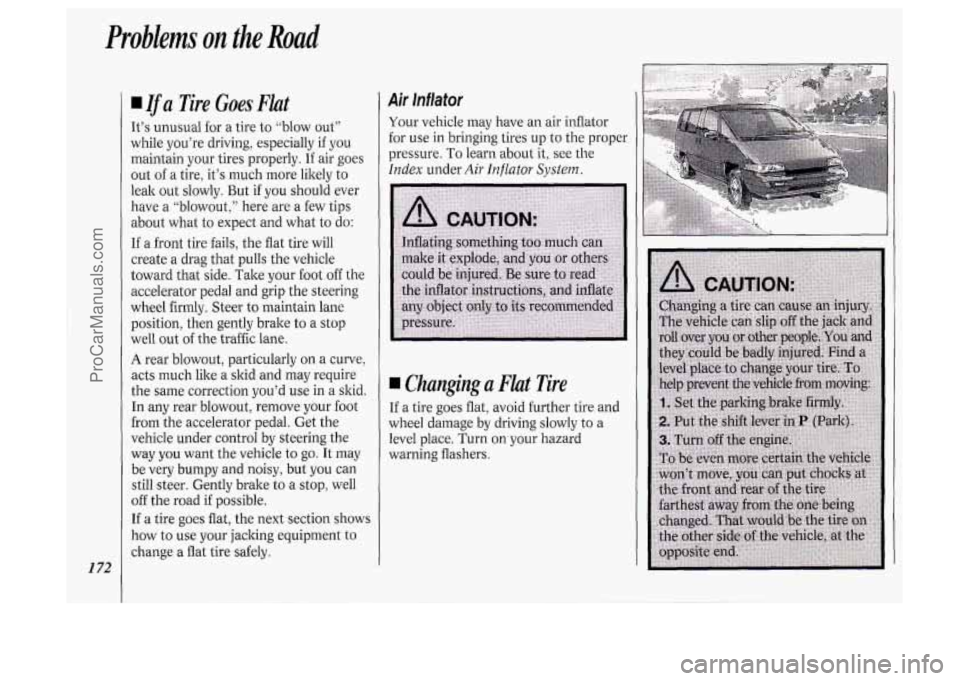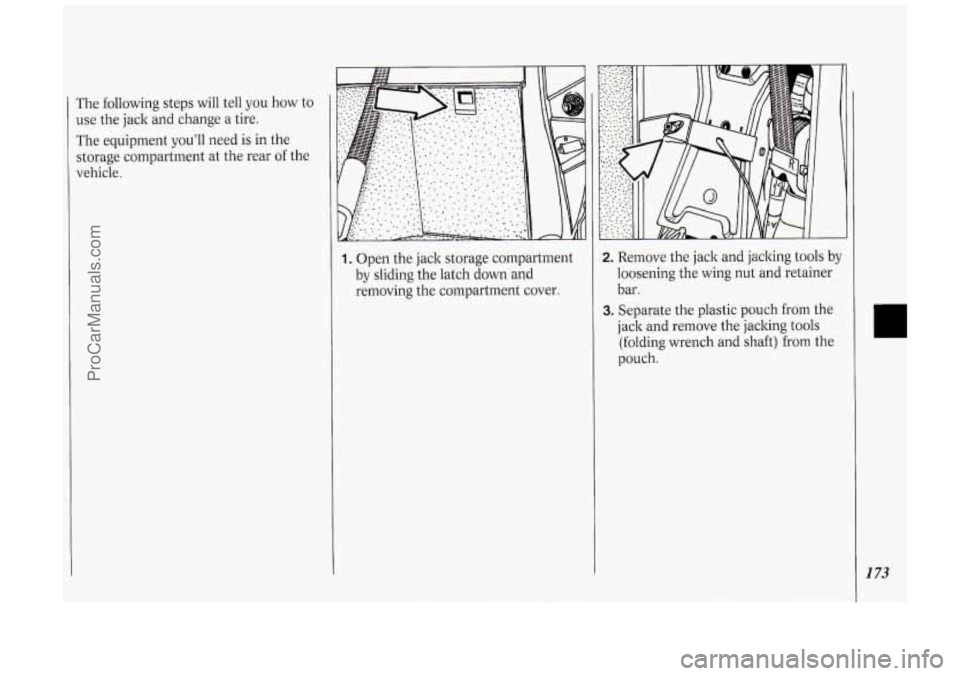jacking OLDSMOBILE SILHOUETTE 1994 Owners Manual
[x] Cancel search | Manufacturer: OLDSMOBILE, Model Year: 1994, Model line: SILHOUETTE, Model: OLDSMOBILE SILHOUETTE 1994Pages: 276, PDF Size: 15.82 MB
Page 174 of 276

Problems on the Road
1 72
Ifa Tire Goes Flat
It’s unusual for a tire to “blow out”
while you’re driving, especially if
you
maintain your tires properly. If air goes
out of a tire, it’s much more likely to
leak out slowly. But
if you should ever
have a “blowout,” here are a few tips
about what to expect and what to do:
If a front tire fails, the flat tire will
create a drag that pulls the vehicle
toward that side. Take your foot
off the
accelerator pedal and grip the steering
wheel firmly. Steer
to maintain lane
position, then gently brake to a stop
well
out of the traffic lane.
A rear blowout, particularly on a curve,
acts much like a skid and may require
the same correction you’d use in a skid.
In any rear blowout, remove your foot
from the accelerator pedal. Get the
vehicle under control by steering the
way
you want the vehicle to go. It may
be very bumpy and noisy, but you can
still steer. Gently brake to a stop, well
off the road if possible.
If a tire goes flat, the next section shows
how to
use your jacking equipment to
change a flat tire safely.
Air Inflator
Your vehicle may have an air inflator
for use in bringing tires up to the proper
pressure.
To learn about it, see the
Index under Air Inflator System.
Changing a Flat Tire
If a tire goes flat, avoid further tire and
wheel damage by driving slowly to a
level place. Turn on your hazard
warning flashers.
ProCarManuals.com
Page 175 of 276

The following steps will tell you how to
use the jack and change
a tire.
The equipment you’ll need is in the
storage compartment
at the rear of the
vehicle.
1. Open the jack storage compartment
by sliding the latch down and
removing the compartment cover.
2. Remove the jack and jacking tools by
loosening the wing nut and retainer
bar.
3. Separate the plastic pouch from the
jack and remove the jacking tools
(folding wrench and shaft) from the
pouch.
I 73
ProCarManuals.com
Page 180 of 276

Problems on the Road
1 78
17. Lay the flat tire near the rear of the
vehicle with the valve stem down.
Slide the cable retainer through the
center of the wheel and raise the flat
tire until you hear the hoist
mechanism click twice. This means
the wheel is firmly stored against
the underside of the vehicle. When
storing the spare tire, be certain to
turn the spare
so the valve stem is
near the rear of the vehicle. This
will help you to check and maintain
tire pressure in the spare.
Push against the tire to be certain it
is stored firmly.
18. Replace all jacking tools as they were
stored in the storage compartment and
replace the compartment cover. Be
sure to also store the nylon nut caps.
When
you replace the compact spare
tire with a full-size tire, replace the
nylon nut caps over the wheel nuts.
Tighten them “hand tight” using the
folding wrench (see step
7).
Compact Spare Tire
Although the compact spare was fr .Ill!
inflatedwhen you; vehiile was new, :
can lose air after a time. Check the
jr
it
inflation pressure regularly. It should be
60 psi (420 1tPa). After installing the
compact spare on your vehicle, you
should stop as soon as possible and
make sure your spare tire is correctly
inflated. The compact spare is made to
perform well at posted speed limits for
distances up to
3,000 miles (5 000 ltm).
The compact spare
is made to go up to
3,000 miles (5 000 ltm), so you can
finish your trip and have your full-size
tire repaired
or replaced where you
want. Of course, it’s best to replace
your spare with
a full-size tire as soon
as you can. Your spare will last longer
and be in good shape in case you need it
again.
ProCarManuals.com